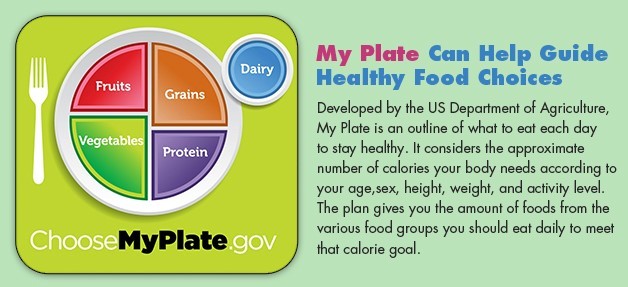Eating nutritious foods and being physically active are important for people with blood and bleeding disorders. Making healthy eating and activity choices can support healthy bodies and joints. Teens and adults need nutritious food with enough protein, carbs, fats, vitamins, minerals, and fiber to support their growing bodies. It is also important for teens to eat foods with other important nutrients like calcium and iron. Following nutrition and physical activity guidelines can support healthy eating and physical activity habits that will continue throughout life.
The Importance of Iron and Calcium During Puberty
What is Healthy Eating?
Nutrition and food choices are not a one-size-fits-all solution. The best amount and types of food for one person may not work for another. Your nutritional needs are based on factors like age, stage of life, bloodwork results, lifestyle, allergies, dietary restrictions, and health status including what type of illnesses you may have.4
Models of basic nutritional needs, like My Plate, can be used as a guide but do not always apply to everyone equally. Also, the quality of food is just as important as the quantity of food. While nutritional needs may vary, there are some basic nutrition facts that are true no matter your age or stage of life. These may help guide you as you make decisions based on your individual needs. Talk with a health care provider before making any changes to your diet or if you have specific questions.

The Importance of Iron and Calcium During Puberty
During puberty, teens undergo dramatic physical growth and development. With increased growth teen bodies need more energy, protein, vitamins, and minerals. Their bones are getting longer as they get taller, and the muscles are growing to support those big bones. Two important nutrients for teens are calcium and iron.
Iron builds up blood cells, which may be especially helpful after a bleed or injury. Iron also helps blood carry oxygen to the body's muscles. During a bleed, a small amount of iron is lost. You can maintain adequate iron levels by eating naturally iron-rich foods, such as liver, lean red meat, and poultry. Other sources of iron include leafy green vegetables, broccoli, dried beans, grains, and raisins.
Combining iron-rich foods with good sources of vitamin C (such as orange juice) can help the body absorb iron. Certain foods can also block iron absorption. These foods include coffee, tea, egg yolks, milk, fiber, and soy protein. It is best to avoid eating these and iron-rich foods at the same time.
Women, girls, and those with the potential to menstruate need more iron because people who menstruate lose iron with each menstrual period. People who have heavy periods are at risk of losing too much iron and developing iron-deficiency anemia. Heavy menstrual bleeding (called menorrhagia) is the most common cause of anemia in people who menstruate.
Here are some common signs of anemia:
Tiredness
Weakness
Tingling and numbness in fingers or toes
Sensitivity to cold
Talk to your Hemophilia Treatment Center (HTC) or health care provider about ways to fight iron loss and include iron-rich foods or supplements in your diet.
If you want more information about vitamins and minerals, please go to Vitamins and Minerals.
Tips for Healthy Eating
After knowing some basic facts about nutrition here are some food choice tips to think about4:
The quality of the food you choose is important. When shopping, look at the ingredients of items like peanut butter, cereal, and crackers. Usually, the fewer ingredients the better.
Everything in moderation. Unless you are allergic or have dietary restrictions there is no such thing as ‘bad’ food. You can eat a lot of foods like fruits and vegetables. Other foods like cookies should be eaten in moderation.
Eat a variety of foods. The more colorful the plate, the better!
Eat protein, fats, and carbs at every meal to stabilize blood sugar and allow for good digestion.
Listen to your body. What foods make you feel good? Are there foods that do not make you feel good? Which ones? Even if they are considered ‘healthy,’ think about what works for your body.
Think about how you choose and cook your food. If possible, choose baked, broiled, or grilled meats, poultry, and fish over fried ones.
Remember, before taking any vitamins or supplements, talk with your Hemophilia Treatment Center (HTC) or health care provider.
Resources
Below you will find a list of resources to help you plan healthy meals and provide you with additional information.
Carreiro, A. L., Dhillon, J., Gordon, S., Higgins, K. A., Jacobs, A. G., McArthur, B. M., … Mattes, R. D. (2016). The macronutrients, appetite, and energy intake. Annual Review of Nutrition, 36, 73–103. doi:10.1146/annurev-nutr-121415-112624
Chen, Y., Michalak, M., & Agellon, L. B. (2018). Importance of nutrients and nutrient metabolism on human health. The Yale Journal of Biology and Medicine, 91(2), 95–103. Retrieved from https://www.ncbi.nlm.nih.gov/pubmed/29955217
Morris AL, Mohiuddin SS. (2022). Biochemistry, Nutrients. StatPearls [Internet]. Treasure Island (FL): StatPearls Publishing. Retrieved from: https://www.ncbi.nlm.nih.gov/books/NBK554545/
Sears, W., M.D., Sears, M., R.N., Sears, J., M.D., & Sears, R., M.D. (2006). The healthiest kid in the neighborhood: Ten ways to get your family on the right nutritional track. New York, NY: Little, Brown Spark.
Venn, B. J. (2020a). Macronutrients and human health for the 21st century. Nutrients, 12(8), 2363. doi:10.3390/nu12082363
